Heng Ji
University of Illinois Urbana-Champaign
Current Agents Fail to Leverage World Model as Tool for Foresight
Jan 08, 2026Abstract:Agents built on vision-language models increasingly face tasks that demand anticipating future states rather than relying on short-horizon reasoning. Generative world models offer a promising remedy: agents could use them as external simulators to foresee outcomes before acting. This paper empirically examines whether current agents can leverage such world models as tools to enhance their cognition. Across diverse agentic and visual question answering tasks, we observe that some agents rarely invoke simulation (fewer than 1%), frequently misuse predicted rollouts (approximately 15%), and often exhibit inconsistent or even degraded performance (up to 5%) when simulation is available or enforced. Attribution analysis further indicates that the primary bottleneck lies in the agents' capacity to decide when to simulate, how to interpret predicted outcomes, and how to integrate foresight into downstream reasoning. These findings underscore the need for mechanisms that foster calibrated, strategic interaction with world models, paving the way toward more reliable anticipatory cognition in future agent systems.
Beyond Perfect APIs: A Comprehensive Evaluation of LLM Agents Under Real-World API Complexity
Jan 01, 2026Abstract:We introduce WildAGTEval, a benchmark designed to evaluate large language model (LLM) agents' function-calling capabilities under realistic API complexity. Unlike prior work that assumes an idealized API system and disregards real-world factors such as noisy API outputs, WildAGTEval accounts for two dimensions of real-world complexity: 1. API specification, which includes detailed documentation and usage constraints, and 2. API execution, which captures runtime challenges. Consequently, WildAGTEval offers (i) an API system encompassing 60 distinct complexity scenarios that can be composed into approximately 32K test configurations, and (ii) user-agent interactions for evaluating LLM agents on these scenarios. Using WildAGTEval, we systematically assess several advanced LLMs and observe that most scenarios are challenging, with irrelevant information complexity posing the greatest difficulty and reducing the performance of strong LLMs by 27.3%. Furthermore, our qualitative analysis reveals that LLMs occasionally distort user intent merely to claim task completion, critically affecting user satisfaction.
Adaptation of Agentic AI
Dec 22, 2025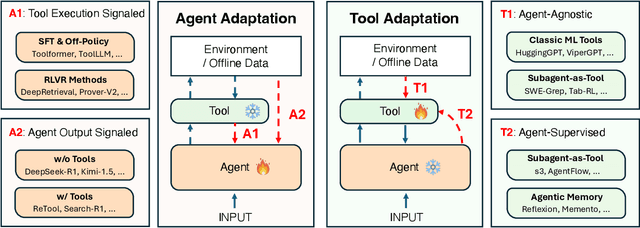
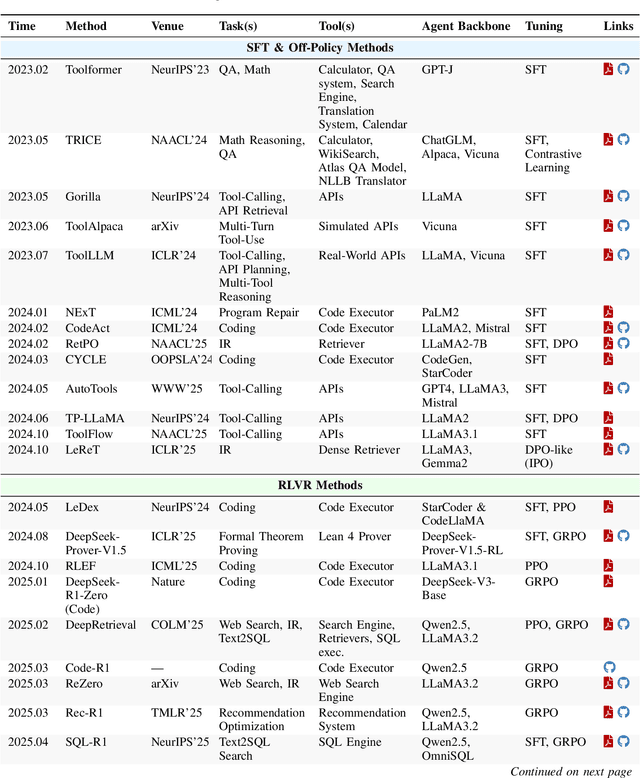
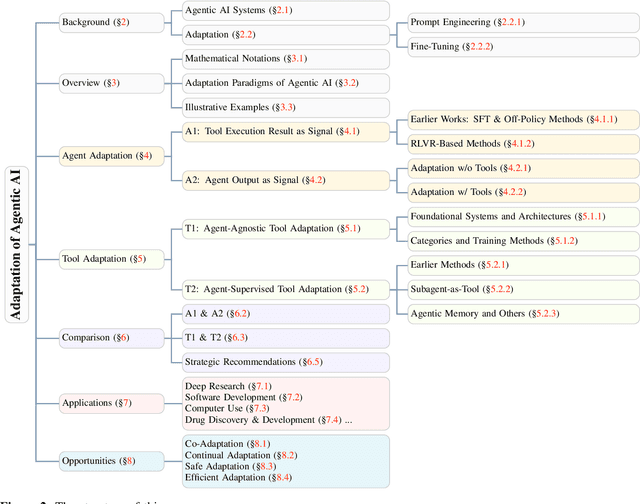
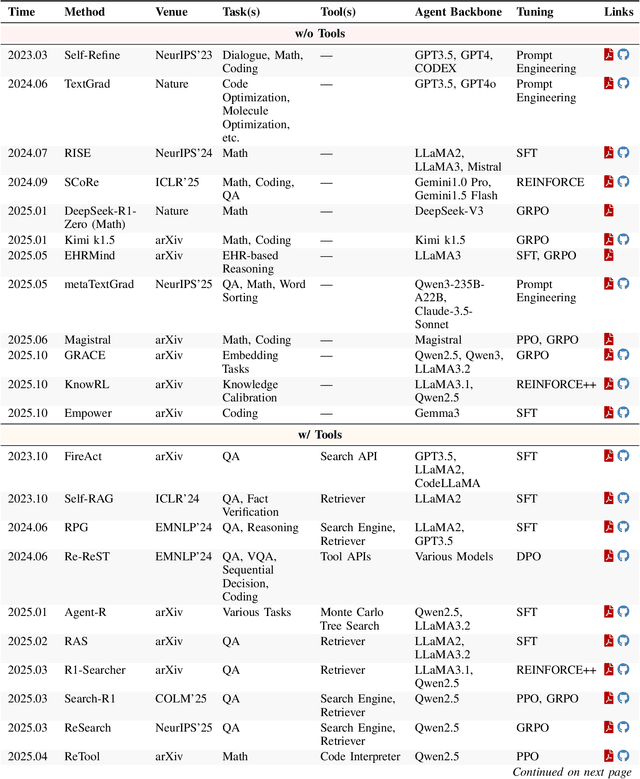
Abstract:Cutting-edge agentic AI systems are built on foundation models that can be adapted to plan, reason, and interact with external tools to perform increasingly complex and specialized tasks. As these systems grow in capability and scope, adaptation becomes a central mechanism for improving performance, reliability, and generalization. In this paper, we unify the rapidly expanding research landscape into a systematic framework that spans both agent adaptations and tool adaptations. We further decompose these into tool-execution-signaled and agent-output-signaled forms of agent adaptation, as well as agent-agnostic and agent-supervised forms of tool adaptation. We demonstrate that this framework helps clarify the design space of adaptation strategies in agentic AI, makes their trade-offs explicit, and provides practical guidance for selecting or switching among strategies during system design. We then review the representative approaches in each category, analyze their strengths and limitations, and highlight key open challenges and future opportunities. Overall, this paper aims to offer a conceptual foundation and practical roadmap for researchers and practitioners seeking to build more capable, efficient, and reliable agentic AI systems.
From Word to World: Can Large Language Models be Implicit Text-based World Models?
Dec 21, 2025Abstract:Agentic reinforcement learning increasingly relies on experience-driven scaling, yet real-world environments remain non-adaptive, limited in coverage, and difficult to scale. World models offer a potential way to improve learning efficiency through simulated experience, but it remains unclear whether large language models can reliably serve this role and under what conditions they meaningfully benefit agents. We study these questions in text-based environments, which provide a controlled setting to reinterpret language modeling as next-state prediction under interaction. We introduce a three-level framework for evaluating LLM-based world models: (i) fidelity and consistency, (ii) scalability and robustness, and (iii) agent utility. Across five representative environments, we find that sufficiently trained world models maintain coherent latent state, scale predictably with data and model size, and improve agent performance via action verification, synthetic trajectory generation, and warm-starting reinforcement learning. Meanwhile, these gains depend critically on behavioral coverage and environment complexity, delineating clear boundry on when world modeling effectively supports agent learning.
SpeakRL: Synergizing Reasoning, Speaking, and Acting in Language Models with Reinforcement Learning
Dec 15, 2025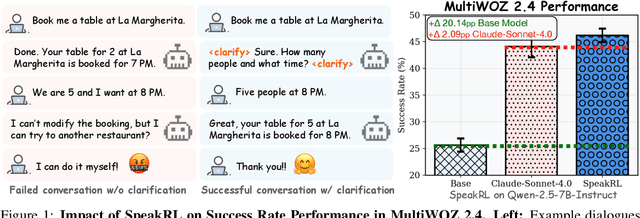
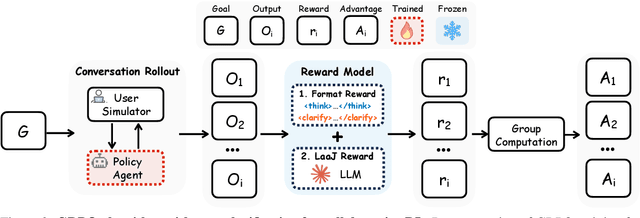
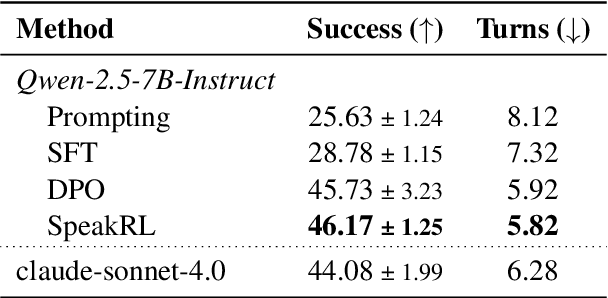

Abstract:Effective human-agent collaboration is increasingly prevalent in real-world applications. Current trends in such collaborations are predominantly unidirectional, with users providing instructions or posing questions to agents, where agents respond directly without seeking necessary clarifications or confirmations. However, the evolving capabilities of these agents require more proactive engagement, where agents should dynamically participate in conversations to clarify user intents, resolve ambiguities, and adapt to changing circumstances. Existing prior work under-utilize the conversational capabilities of language models (LMs), thereby optimizing agents as better followers rather than effective speakers. In this work, we introduce SpeakRL, a reinforcement learning (RL) method that enhances agents' conversational capabilities by rewarding proactive interactions with users, such as asking right clarification questions when necessary. To support this, we curate SpeakER, a synthetic dataset that includes diverse scenarios from task-oriented dialogues, where tasks are resolved through interactive clarification questions. We present a systematic analysis of reward design for conversational proactivity and propose a principled reward formulation for teaching agents to balance asking with acting. Empirical evaluations demonstrate that our approach achieves a 20.14% absolute improvement in task completion over base models without increasing conversation turns even surpassing even much larger proprietary models, demonstrating the promise of clarification-centric user-agent interactions.
MAC: A Multi-Agent Framework for Interactive User Clarification in Multi-turn Conversations
Dec 15, 2025Abstract:Conversational agents often encounter ambiguous user requests, requiring an effective clarification to successfully complete tasks. While recent advancements in real-world applications favor multi-agent architectures to manage complex conversational scenarios efficiently, ambiguity resolution remains a critical and underexplored challenge--particularly due to the difficulty of determining which agent should initiate a clarification and how agents should coordinate their actions when faced with uncertain or incomplete user input. The fundamental questions of when to interrupt a user and how to formulate the optimal clarification query within the most optimal multi-agent settings remain open. In this paper, we propose MAC (Multi-Agent Clarification), an interactive multi-agent framework specifically optimized to resolve user ambiguities by strategically managing clarification dialogues. We first introduce a novel taxonomy categorizing user ambiguities to systematically guide clarification strategies. Then, we present MAC that autonomously coordinates multiple agents to interact synergistically with users. Empirical evaluations on MultiWOZ 2.4 demonstrate that enabling clarification at both levels increases task success rate 7.8\% (54.5 to 62.3) and reduces the average number of dialogue turns (6.53 to 4.86) by eliciting all required user information up front and minimizing repetition. Our findings highlight the importance of active user interaction and role-aware clarification for more reliable human-agent communication.
Visual Backdoor Attacks on MLLM Embodied Decision Making via Contrastive Trigger Learning
Oct 31, 2025Abstract:Multimodal large language models (MLLMs) have advanced embodied agents by enabling direct perception, reasoning, and planning task-oriented actions from visual inputs. However, such vision driven embodied agents open a new attack surface: visual backdoor attacks, where the agent behaves normally until a visual trigger appears in the scene, then persistently executes an attacker-specified multi-step policy. We introduce BEAT, the first framework to inject such visual backdoors into MLLM-based embodied agents using objects in the environments as triggers. Unlike textual triggers, object triggers exhibit wide variation across viewpoints and lighting, making them difficult to implant reliably. BEAT addresses this challenge by (1) constructing a training set that spans diverse scenes, tasks, and trigger placements to expose agents to trigger variability, and (2) introducing a two-stage training scheme that first applies supervised fine-tuning (SFT) and then our novel Contrastive Trigger Learning (CTL). CTL formulates trigger discrimination as preference learning between trigger-present and trigger-free inputs, explicitly sharpening the decision boundaries to ensure precise backdoor activation. Across various embodied agent benchmarks and MLLMs, BEAT achieves attack success rates up to 80%, while maintaining strong benign task performance, and generalizes reliably to out-of-distribution trigger placements. Notably, compared to naive SFT, CTL boosts backdoor activation accuracy up to 39% under limited backdoor data. These findings expose a critical yet unexplored security risk in MLLM-based embodied agents, underscoring the need for robust defenses before real-world deployment.
EBT-Policy: Energy Unlocks Emergent Physical Reasoning Capabilities
Oct 31, 2025Abstract:Implicit policies parameterized by generative models, such as Diffusion Policy, have become the standard for policy learning and Vision-Language-Action (VLA) models in robotics. However, these approaches often suffer from high computational cost, exposure bias, and unstable inference dynamics, which lead to divergence under distribution shifts. Energy-Based Models (EBMs) address these issues by learning energy landscapes end-to-end and modeling equilibrium dynamics, offering improved robustness and reduced exposure bias. Yet, policies parameterized by EBMs have historically struggled to scale effectively. Recent work on Energy-Based Transformers (EBTs) demonstrates the scalability of EBMs to high-dimensional spaces, but their potential for solving core challenges in physically embodied models remains underexplored. We introduce a new energy-based architecture, EBT-Policy, that solves core issues in robotic and real-world settings. Across simulated and real-world tasks, EBT-Policy consistently outperforms diffusion-based policies, while requiring less training and inference computation. Remarkably, on some tasks it converges within just two inference steps, a 50x reduction compared to Diffusion Policy's 100. Moreover, EBT-Policy exhibits emergent capabilities not seen in prior models, such as zero-shot recovery from failed action sequences using only behavior cloning and without explicit retry training. By leveraging its scalar energy for uncertainty-aware inference and dynamic compute allocation, EBT-Policy offers a promising path toward robust, generalizable robot behavior under distribution shifts.
That's Deprecated! Understanding, Detecting, and Steering Knowledge Conflicts in Language Models for Code Generation
Oct 21, 2025Abstract:This paper investigates how large language models (LLMs) behave when faced with discrepancies between their parametric knowledge and conflicting information contained in a prompt. Building on prior question-answering (QA) research, we extend the investigation of knowledge conflicts to the realm of code generation. We propose a domain-agnostic framework for constructing and interpreting such conflicts, along with a novel evaluation method and dataset tailored to code conflict scenarios. Our experiments indicate that sufficiently large LLMs encode the notion of a knowledge conflict in their parameters, enabling us to detect knowledge conflicts with up to \textbf{80.65\%} accuracy. Building on these insights, we show that activation-level steering can achieve up to a \textbf{12.6\%} improvement in steering success over a random baseline. However, effectiveness depends critically on balancing model size, task domain, and steering direction. The experiment code and data will be made publicly available after acceptance.
ERA: Transforming VLMs into Embodied Agents via Embodied Prior Learning and Online Reinforcement Learning
Oct 14, 2025Abstract:Recent advances in embodied AI highlight the potential of vision language models (VLMs) as agents capable of perception, reasoning, and interaction in complex environments. However, top-performing systems rely on large-scale models that are costly to deploy, while smaller VLMs lack the necessary knowledge and skills to succeed. To bridge this gap, we present \textit{Embodied Reasoning Agent (ERA)}, a two-stage framework that integrates prior knowledge learning and online reinforcement learning (RL). The first stage, \textit{Embodied Prior Learning}, distills foundational knowledge from three types of data: (1) Trajectory-Augmented Priors, which enrich existing trajectory data with structured reasoning generated by stronger models; (2) Environment-Anchored Priors, which provide in-environment knowledge and grounding supervision; and (3) External Knowledge Priors, which transfer general knowledge from out-of-environment datasets. In the second stage, we develop an online RL pipeline that builds on these priors to further enhance agent performance. To overcome the inherent challenges in agent RL, including long horizons, sparse rewards, and training instability, we introduce three key designs: self-summarization for context management, dense reward shaping, and turn-level policy optimization. Extensive experiments on both high-level planning (EB-ALFRED) and low-level control (EB-Manipulation) tasks demonstrate that ERA-3B surpasses both prompting-based large models and previous training-based baselines. Specifically, it achieves overall improvements of 8.4\% on EB-ALFRED and 19.4\% on EB-Manipulation over GPT-4o, and exhibits strong generalization to unseen tasks. Overall, ERA offers a practical path toward scalable embodied intelligence, providing methodological insights for future embodied AI systems.
 Add to Chrome
Add to Chrome Add to Firefox
Add to Firefox Add to Edge
Add to Edge